|
|
- Bali High |
|
On March 23 we left Okinawa to spend a week in Bali. To go anywhere that is someplace from Okinawa you have to go somewhere else. We had to go first to Taipei. Since we didn't have a visa to disembark in Taipei and our flight to Bali didn't leave until the next morning, China Airlines put us up in the Chaing Kai Shek Airport hotel. They took our passports and informed us that we were not to leave the hotel. On the bus to the hotel we met a group or 14 young people who were on their way from Indonesia to New York City. We chatted about New York and told them of places that were a "must see". The conversation brought back thoughts of home and a longing for the good ole USA. The airport hotel wasn't too bad, definitely not as bad as the hotel in Seoul. The wake-up call came very early the next morning but we were excited to see Bali and glad morning had arrived. We were served a full breakfast buffet with fresh fruit and strong, hot coffee and whisked off to the airport. We flew for almost six hours, over the South China Sea, Manila in the Philippines, Brunei, and Borneo. On our west were Ho Chi Minh City, Thailand, and Viet Nam. To our east were Guam and the wide expanse of the Pacific Ocean. Flying into Denpasar Airport we could see the coastline of Bali with the white sands and crashing waves. After a smooth landing and a check through immigrations we took a 15-minute taxi ride (total cost -20,000 rupiah, about 1.60) to our resort. We stayed at the Royal Bali Beach Club, which is across the street from the Intercontinental Hotel. We were welcomed with delicious fruit drinks and local Balinese playing bamboo instruments. Bali is one of 27 provincial regions of the Republic of Indonesia each ruled by a governor. Eighty to ninety percent of the Balinese are Hindu. They believe in many gods but they all emanate from a single source. Their calendar year or Saka year rules the agricultural cycle. New Years day of the Saka calendar falls on the day after the new moon of the ninth month of the year and marks the end of their rainy season. This year the day after the new moon of the ninth month just happened to be March 25th. Our host at the resort told us about the parade that would take place when night fell and the importance of tomorrow, New Year's Day or Nyepi. Nyepi starts at 6 a.m. and last for twenty-four hours. The day is a day of fasting and silence. When night falls people are not allowed to use electric lights or create fires for cooking. The airport and other transportation are shut down and no work is done. The Balinese hope the evil gods will think that everyone has left the island and go away so they will have a good year. Our host at the resort was worried that we would be disappointed by the need to stay at the resort and be quiet. How wrong he was! What a great day for reading and basking in the sun. The silence, with only the sound of the birds singing, was wonderful after the noise of the streets the night before. The day after Nyepi we began our exploration of the island. Bali is 5,000 square kilometers of land with active volcanoes, tropical rain forests, carefully cultivated rice fields and long, white beaches. The island is right below the equator and is rich with the greenery of the banana palms and the hibiscus trees bearing a variety of colored flowers. The villages that dot the landscape are small compounds surrounded by stonewalls. They are built to face the great mountains that are considered closer to the gods. Every house has its own shrine, each village has a shrine and each compound has a shrine. Many hours each day the women spend time making offering to the gods out of flowers and fruits. They are also skilled at making a soft, colorful cloth called Batek. They use the material for sarongs and scarves and wall hangings. The fibers are colored with local berries and flowers and painted by hand with gold. We took advantage of the cheap prices in Bali and rented a car and a driver for the day (total charge was @$27). He took us through the villages past Ubud to Kintamani to visit an active volcano called Mt. Batur. On the way to the volcano we passed through many villages and were struck by the poverty. The houses have electricity but no running water. We saw a lady washing her clothes in a drainage ditch running along side of the road. We saw clothes laid out on the grassy areas drying in the sun. When I asked our driver about bathing he said there is another ditch with clean water that the people use for bathing. We watched as many women walked along the road with large baskets of goods on their heads. The Balinese have many interesting customs that seemed very strange to us. They give their children the same first name based on their birth order. All first born children, male or female, are called Wayan, second born are Ma'de, third born are Nyoman, and fourth are Ketut. If they have 5, 6, or more children they begin again with Wayan for the fifth children and Ma'de for the sixth and so on. (We wondered why so many people we met had the name of Wayan.) If you empty you plate when you are eating they think you want more food. Next to the sex organs, the feet are considered the lowliest and most profane part of the body. It is impolite to sit with you feet up. You never point at something with your forefinger, always use your thumb. Your left hand is considered unclean because it is used for bodily functions. You never touch anyone or give anything with your left hand. You also never touch someone's head because the head is considered sacred, the seat of the soul. After lunch we descended the mountain and were awe struck by the glorious vista of the Balinese's rice fields. The side of the mountain looked like a picture from National Geographic. The slopes of the mountains make an ideal place for the ingenious irrigation system the Balinese have devised. The land is cut into what looks like giant steps running up the hillsides. The rice is planted on the flat of the steps and water is directed from the mountains to flow down through each flat so more of the land can be flooded to produce the rice. Our driver took me down through the small paths in the terraced landscape so I could see the slopes from below. The paths were narrow with stones here and there to help with your footing. The ledge we walked along was also narrow and gave me the feeling of walking on the edge of a steep mountain. As we walked down two or three levels the breeze blew through the fields and I felt like I could spread my arms and fly. Next we visited the fields that were ready for harvesting and watched as the Balinese harvested the rice by hand. They use no machinery. Several people chop the plants with sickles while others smash the bundled plants against wooden poles to knock the rice off the ends unto large tarps. The tarps are carried by hand to the drying area where the rice is dried in the sun before it is ready for cooking. After a long day of touring the island in the hot sun, we couldn't wait to return to our resort and jump in the cool water of the pool with its waterfall cascading over the rocks. Several dinners on Bali were spent on the beach with two couples we met at our resort. The beach across from our condo is known for its beach shacks that serve great fresh fish and lobster. The shacks sit along the upper part of the beach before it slopes down to the water. Each shack has tables close to the shoreline where you sit to eat you dinner. Dinner is selected from the live fish and lobster that are swimming in the large tanks in the shacks. You are expected to bargain for the price you will pay for your fish and you usually get it for half the asking price. We shared a 5-pound lobster with one of the other couples and paid $8. The dinner included rice, vegetables and a salad. What a deal! Mother nature gave us a beautiful light show as we sat on the beach eating our meal. The storm that was out to sea produced lightening that made the clouds glow over the dark waters. When the lightening stopped, the stars in the southern hemisphere were as magnificent as we had seen in Australia. We could see the Southern Cross and the Milky Way is so much brighter here. Travel in Bali would not be complete without a visit to a Hindu temple. The one we visited was in Uluwatu on a cliff at the southern end of the island. The temple grounds were filled with monkeys who live there in the trees. We were warned to hang on to our belonging, including our glasses, because the monkeys are famous for grabbing anything that isn't tied down. As we walked through the grounds I kept one eye on the monkeys who followed us everywhere. The temple was an open-air style with large gathering rooms used for ceremonies. The structure was built of concrete with ornate carvings in the stone. The view from the grounds looks down to the water where you can see the waves splashing again the high cliffs. When you visit a temple you must cover your legs in a sarong with a scarf that ties around your waist. You, also, never put your head above a priest's head. The legend tells of a love story between the heir to the throne, Prince Rama and his wife Sita. A demon king, Rahwana, lusts after Sita and steals her away from Rama. The white monkey, Hanoman, saves Sita and returns her to Rama. Hanoman's magical powers also allow him to escape the fire he has been thrown in by the evil king. All live happily ever after. Not quite your Cinderella story, but close. We could have lived happily ever after in Bali if it weren't so far away from OUR world.
Map of Japan - provided by the CIA
Note: Not all pictures were not taken by my mom. Some pictures were found on the internet. |
|
 We have vacationed on the wide, white beaches of the Florida gulf coast. We have taken several trips to the beaches of the Bahamas and basked under the shade of the palm trees. We have traveled to Hawaii and spent a week on the north shore of Oahu. We have walked the beaches of the California coast from San Francisco to San Diego. We have sat among the tall grasses of the shores of North and South Carolina. And there is nothing like the glorious white, fine sand of the south Jersey shore where I first learned to love the beach. This year we have logged many hours on the beaches of the East China Sea and enjoyed the turquoise water and bright colored coral. We visited Manly Beach, Australia and watched the surfers as they mastered the crest of the waves. And now the High that only comes from the Indian Ocean with its rocky cliffs surrounding the beach on Jimbaran Bay in Bali.
We have vacationed on the wide, white beaches of the Florida gulf coast. We have taken several trips to the beaches of the Bahamas and basked under the shade of the palm trees. We have traveled to Hawaii and spent a week on the north shore of Oahu. We have walked the beaches of the California coast from San Francisco to San Diego. We have sat among the tall grasses of the shores of North and South Carolina. And there is nothing like the glorious white, fine sand of the south Jersey shore where I first learned to love the beach. This year we have logged many hours on the beaches of the East China Sea and enjoyed the turquoise water and bright colored coral. We visited Manly Beach, Australia and watched the surfers as they mastered the crest of the waves. And now the High that only comes from the Indian Ocean with its rocky cliffs surrounding the beach on Jimbaran Bay in Bali.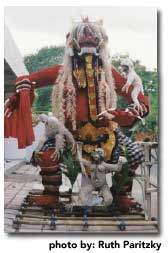 We settled into our condo and took off to see the sights. The Balinese had constructed large wooden and paper statues, called Ogahs, to sacrifice to the gods in a ceremony that would take place in a few hours. The Ogahs are carried on platforms of wood and paraded through the streets of the villages and down to the beach. When they reach the beach they are burned in a tribute to the gods. Children carry sparklers and throw firecrackers in the streets as they march along. The partying goes on long into the night in preparation for the solitude that will take place the next day.
We settled into our condo and took off to see the sights. The Balinese had constructed large wooden and paper statues, called Ogahs, to sacrifice to the gods in a ceremony that would take place in a few hours. The Ogahs are carried on platforms of wood and paraded through the streets of the villages and down to the beach. When they reach the beach they are burned in a tribute to the gods. Children carry sparklers and throw firecrackers in the streets as they march along. The partying goes on long into the night in preparation for the solitude that will take place the next day.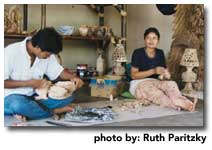 The Balinese produce furniture and statues out of the wood from local trees. We visited the shops where the wood is carefully chiseled into masks and lamps and statues of all shapes and designs. We sat at a large dining room table that was made by the skill of some graceful wood carver. We felt the weight of the items carved from mahogany wood and the softness of the teak. I wished our suitcases were bigger so I could have brought some of these lovely pieces home.
The Balinese produce furniture and statues out of the wood from local trees. We visited the shops where the wood is carefully chiseled into masks and lamps and statues of all shapes and designs. We sat at a large dining room table that was made by the skill of some graceful wood carver. We felt the weight of the items carved from mahogany wood and the softness of the teak. I wished our suitcases were bigger so I could have brought some of these lovely pieces home.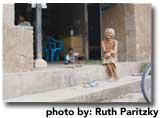 At one village our driver stopped and asked a family if we could see their house. The kitchen was a small concrete closet with a hole for the fire's smoke to escape and a counter made of stone holding a large dishpan full of dirty water. We were shown the shrine and a large wood platform that is the ceremonial bed. This platform is used for special occasions and celebrations. One of the major celebrations is the filing of the front teeth when a young person turns 16 years old. The Hindus believe that this filing will take away the evil traits of jealousy, hate, envy and greed. Our driver proudly told us about his teeth filing and showed us his flat front teeth.
At one village our driver stopped and asked a family if we could see their house. The kitchen was a small concrete closet with a hole for the fire's smoke to escape and a counter made of stone holding a large dishpan full of dirty water. We were shown the shrine and a large wood platform that is the ceremonial bed. This platform is used for special occasions and celebrations. One of the major celebrations is the filing of the front teeth when a young person turns 16 years old. The Hindus believe that this filing will take away the evil traits of jealousy, hate, envy and greed. Our driver proudly told us about his teeth filing and showed us his flat front teeth. 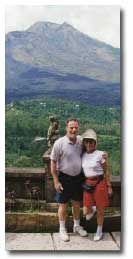 We continued our drive up to Kintamani where the air was cool and the great volcano called Mt. Batur rose up above Lake Batur and the villages below. The last time Mt. Batur exhibited a major eruption was in 1991 but you could still see the dark ash around the sides of the mountain. We had lunch at a mountain top restaurant overlooking the volcano, the lake and the villages below.
We continued our drive up to Kintamani where the air was cool and the great volcano called Mt. Batur rose up above Lake Batur and the villages below. The last time Mt. Batur exhibited a major eruption was in 1991 but you could still see the dark ash around the sides of the mountain. We had lunch at a mountain top restaurant overlooking the volcano, the lake and the villages below. 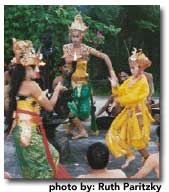 The Kecak Dance is another must to see in Bali. This dance is performed without music. Seventy men chanting throughout the performance do the rhythm for the dance. It is believed that the performers are in a trance and communicating with the deities or ancestors and the deities are communicating back using the dancers as a medium. The Ramayana Epic is an old legend told through the Kecak dance. It is often called the fire dance because part of the story involves the burning of Hanoman, a white monkey with great magical powers.
The Kecak Dance is another must to see in Bali. This dance is performed without music. Seventy men chanting throughout the performance do the rhythm for the dance. It is believed that the performers are in a trance and communicating with the deities or ancestors and the deities are communicating back using the dancers as a medium. The Ramayana Epic is an old legend told through the Kecak dance. It is often called the fire dance because part of the story involves the burning of Hanoman, a white monkey with great magical powers.